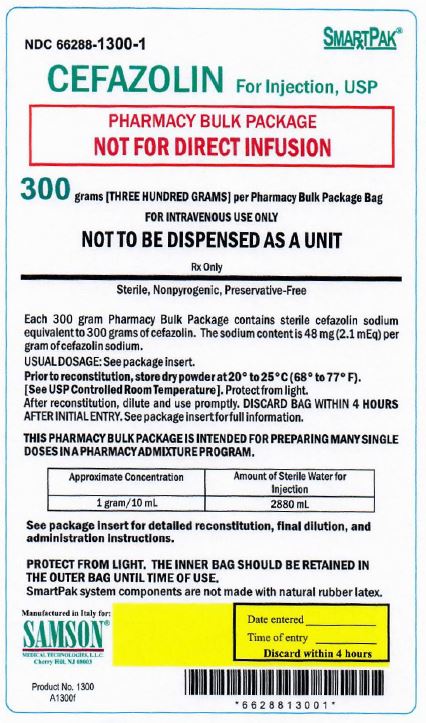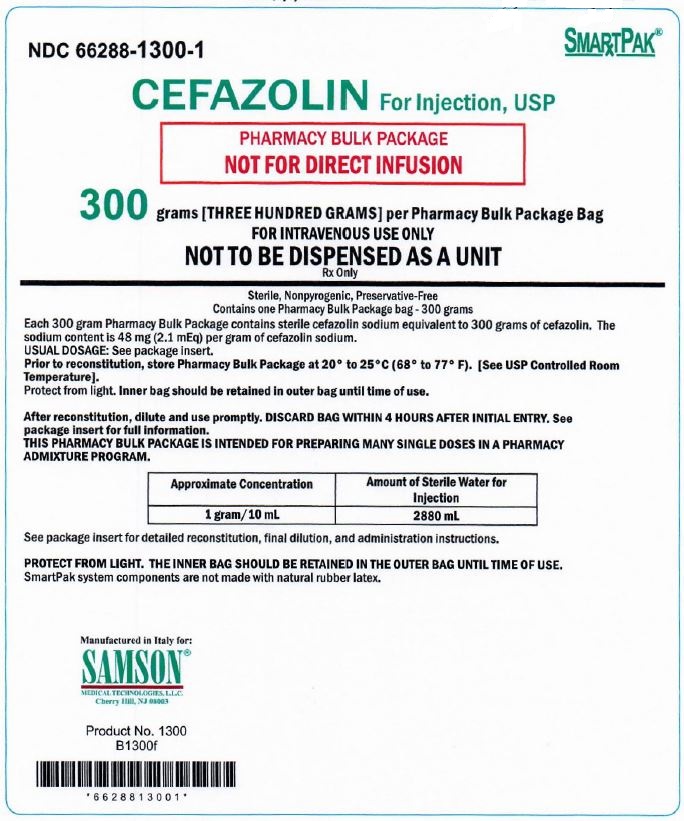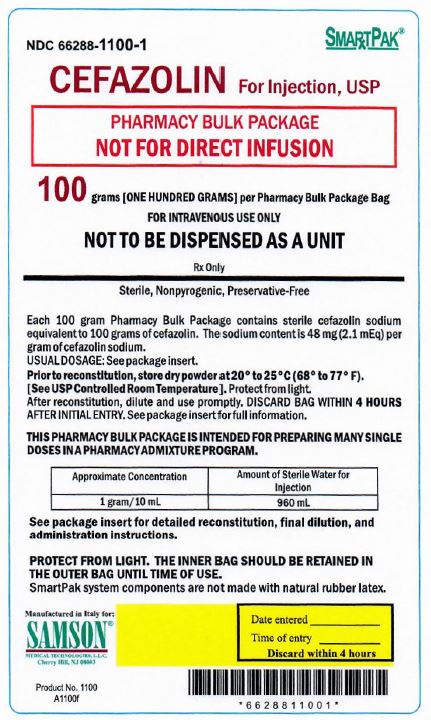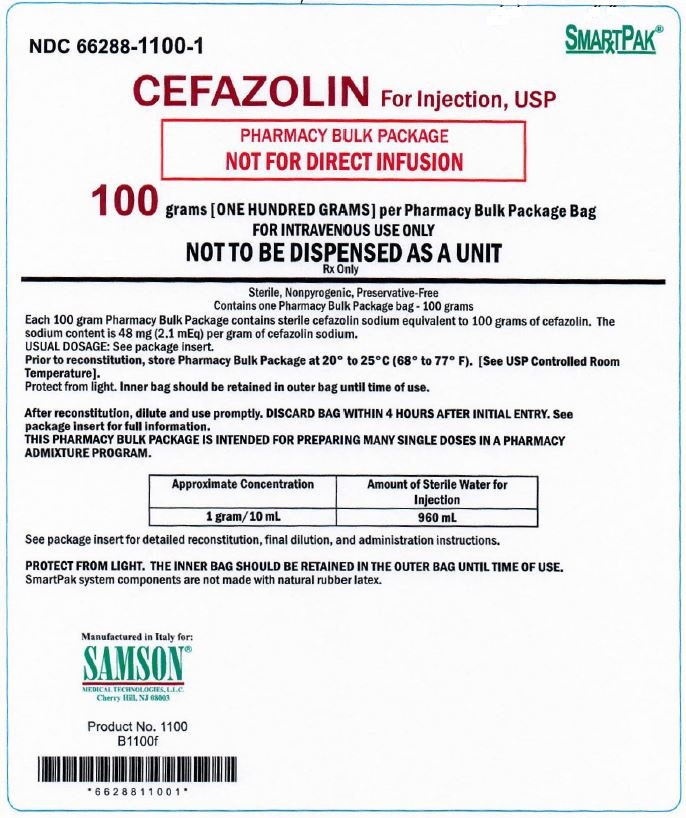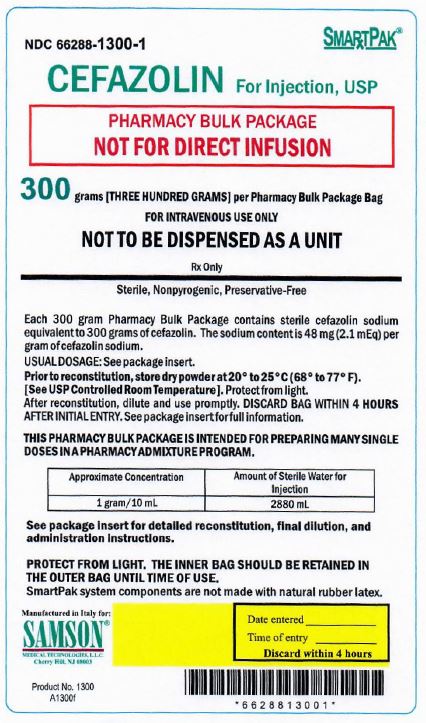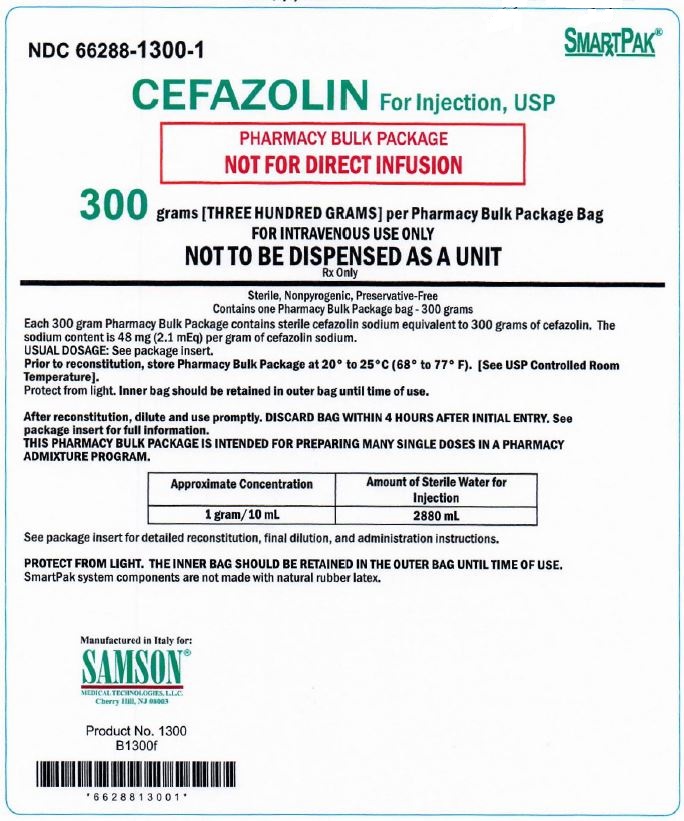Label: CEFAZOLIN- cefazolin sodium injection, powder, lyophilized, for solution
- NDC Code(s): 66288-1100-1, 66288-1300-1
- Packager: Samson Medical Technologies, L.L.C.
- Category: HUMAN PRESCRIPTION DRUG LABEL
- DEA Schedule: None
- Marketing Status: Abbreviated New Drug Application
Drug Label Information
Updated November 8, 2020
If you are a consumer or patient please visit this version.
- Download DRUG LABEL INFO: PDF XML
- Official Label (Printer Friendly)
-
HIGHLIGHTS OF PRESCRIBING INFORMATION
These highlights do not include all the information needed to use Cefazolin for Injection, USP safely and effectively. See full prescribing information for Cefazolin for Injection, USP.
CEFAZOLIN FOR INJECTION, USP
Initial U.S. Approval: 1973PHARMACY BULK PACKAGE -
NOT FOR DIRECT INFUSIONTo reduce the development of drug-resistant bacteria and maintain the effectiveness of cefazolin and other antibacterial drugs, cefazolin should be used only to treat or prevent infections that are proven or strongly suspected to be caused by bacteria. (12.4)
INDICATIONS AND USAGE
Cefazolin for Injection, USP is a cephalosporin antibacterial indicated in the treatment of the following infections caused by susceptible isolates of the designated microorganisms: Respiratory tract infections (1.1); urinary tract infections (1.2); skin and skin structure infections (1.3); biliary tract infections (1.4); bone and joint infections (1.5); genital infections (1.6); septicemia (1.7); endocarditis (1.8); and perioperative prophylaxis (1.9).
DOSAGE AND ADMINISTRATION
For intravenous use only over approximately 30 minutes. (2)
THIS IS A PHARMACY BULK PACKAGE NOT FOR DIRECT INJECTION.
Cefazolin for Injection USP, Pharmacy Bulk Package bag SmartPak® should not be used in patients who require less than a 250 mg dose of cefazolin (2.1)
Recommended Dosing Schedule in Adult Patients with CrCl Greater Than or Equal to 55 mL/min (2.1) Site and Type of Infection Dose Frequency Moderate to severe infections 500 mg to 1 gram Every 6 to 8 hours Mild infections caused by susceptible gram-positive cocci 250 mg to 500 mg Every 8 hours Acute, uncomplicated urinary tract infections 1 gram Every 12 hours Pneumococcal pneumonia 500 mg Every 12 hours Severe, life-threatening infections (e.g., endocarditis, septicemia)* 1 gram to 1.5 grams Every 6 hours
Perioperative prophylaxis1 gram to 2 grams ½ to 1 hour prior to start of surgery 500 mg to 1 gram During surgery for lengthy procedures 500 mg to 1 gram Every 6 to 8 hours for 24 hours postoperatively *In rare instances, doses of up to 12 grams of cefazolin per day have been used. Cefazolin for Injection USP, Pharmacy Bulk Package bag SmartPak® should not be used in patients who require less than a 250 mg dose of cefazolin (2.1) DOSAGE FORMS AND STRENGTHS
Pharmacy Bulk Package bags, 100 grams and 300 grams (3)
THIS IS A PHARMACY BULK PACKAGE – NOT FOR DIRECT INJECTION
CONTRAINDICATIONS
Hypersensitivity to cefazolin or other cephalosporin class antibacterial drugs, penicillins or other beta-lactams (4.1)
WARNINGS AND PRECAUTIONS
- Hypersensitivity reactions: Cross-hypersensitivity may occur in up to 10% of patients with a history of penicillin allergy. If an allergic reaction occurs, discontinue the drug. (5.1)
- Use in patients with renal impairment: Cefazolin for Injection USP, Pharmacy Bulk Package bag SmartPak® should not be used in patients who require less than a 250 mg dose of cefazolin: Dose adjustment required for patients with CrCl less than 55 mL/min. (5.2)
- Clostridium difficile-associated diarrhea: May range from mild diarrhea to fatal colitis. Evaluate if diarrhea occurs. (5.3)
ADVERSE REACTIONS
Most common adverse reactions: gastrointestinal (nausea, vomiting, diarrhea) and allergic reactions (anaphylaxis, urticaria, skin rash). (6)
To report SUSPECTED ADVERSE REACTIONS, contact Samson Medical Technologies, L.L.C. at 1-877-418-3600 or FDA at 1-800-FDA-1088 or www.fda.gov/medwatch
DRUG INTERACTIONS
Probenecid may decrease renal tubular secretion of cephalosporins when used concurrently, resulting in increased and more prolonged cephalosporin blood concentrations. (7)
USE IN SPECIFIC POPULATIONS
- Pediatric Use: Cefazolin for Injection USP – Pharmacy Bulk Package bag, SmartPak® should not be used in pediatric patients who require less than a 250 mg dose of cefazolin. (8.4)
- Renal Impairment: Cefazolin for Injection USP – Pharmacy Bulk Package bag SmartPak® should not be used in renally impaired patients who require less than a 250 mg dose of cefazolin. Lower daily dosage of Cefazolin for Injection is required in patients with impaired renal function (creatinine clearance less than 55 mL/min.) (8.6)
See 17 for PATIENT COUNSELING INFORMATION.
Revised: 11/2020
-
Table of Contents
FULL PRESCRIBING INFORMATION: CONTENTS*
1 INDICATIONS AND USAGE
1.1 Respiratory Tract Infections
1.2 Urinary Tract Infections
1.3 Skin and Skin Structure Infections
1.4 Biliary Tract Infections
1.5 Bone and Joint Infections
1.6 Genital Infections
1.7 Septicemia
1.8 Endocarditis
1.9 Perioperative Prophylaxis
2 DOSAGE AND ADMINISTRATION
2.1 Adult Population
2.2 Perioperative Prophylactic Use
2.3 Patients with Renal Impairment
2.4 Preparation for Use of Cefazolin for Injection, USP bag SmartPak® Pharmacy Bulk Package
3 DOSAGE FORMS AND STRENGTHS
4 CONTRAINDICATIONS
4.1 Hypersensitivity to Cefazolin or the Cephalosporin Class of Antibacterial Drugs, Penicillins or Other Beta-lactams
5 WARNINGS AND PRECAUTIONS
5.1 Hypersensitivity Reactions to Cefazolin, Cephalosporins, Penicillins or Other Beta-lactams
5.2 Use in Patients with Renal Impairment
5.3 Clostridium difficile-associated Diarrhea
5.4 Risk of Development of Drug-resistant Bacteria
5.5 Drug/Laboratory Test Interactions
6 ADVERSE REACTIONS
6.1 Clinical Trials Experience
6.2 Cephalosporin-class Adverse Reactions
7 DRUG INTERACTIONS
8 USE IN SPECIFIC POPULATIONS
8.1 Pregnancy
8.2 Labor and Delivery
8.3 Nursing Mothers
8.4 Pediatric Use
8.5 Geriatric Use
8.6 Patients with Renal Impairment
11 DESCRIPTION
12 CLINICAL PHARMACOLOGY
12.1 Mechanism of Action
12.2 Pharmacodynamics
12.3 Pharmacokinetics
12.4 Microbiology
13 NONCLINICAL TOXICOLOGY
13.1 Carcinogenesis, Mutagenesis, Impairment of Fertility
16 HOW SUPPLIED/STORAGE AND HANDLING
17 PATIENT COUNSELING INFORMATION
- *
- Sections or subsections omitted from the full prescribing information are not listed.
-
1 INDICATIONS AND USAGE
To reduce the development of drug-resistant bacteria and maintain the effectiveness of cefazolin and other antibacterial drugs, cefazolin should be used only to treat or prevent infections that are proven or strongly suspected to be caused by susceptible bacteria. When culture and susceptibility information are available, they should be considered in selecting or modifying antibacterial therapy. In the absence of such data, local epidemiology and susceptibility patterns may contribute to the empiric selection of therapy.
Cefazolin for Injection is indicated for the treatment of the following infections when caused by susceptible bacteria.
1.1 Respiratory Tract Infections
Respiratory tract infections due to Streptococcus pneumoniae, Staphylococcus aureus and Streptococcus pyogenes.
Injectable benzathine penicillin is considered the drug of choice in treatment and prevention of streptococcal infections, including the prophylaxis of rheumatic fever.
Cefazolin is effective in the eradication of streptococci from the nasopharynx; however, data establishing the efficacy of cefazolin in the subsequent prevention of rheumatic fever are not available.
1.2 Urinary Tract Infections
Urinary tract infections due to Escherichia coli and Proteus mirabilis.
1.3 Skin and Skin Structure Infections
Skin and skin structure infections due to S. aureus, S. pyogenes, and Streptococcus agalactiae.
1.4 Biliary Tract Infections
Biliary infections due to E. coli, various isolates of streptococci, P. mirabilis, and S. aureus.
1.9 Perioperative Prophylaxis
The prophylactic administration of cefazolin preoperatively, intraoperatively, and postoperatively may reduce the incidence of certain postoperative infections in patients undergoing surgical procedures which are classified as contaminated or potentially contaminated (e.g., vaginal hysterectomy, and cholecystectomy in high-risk patients such as those older than 70 years, with acute cholecystitis, obstructive jaundice, or common duct bile stones).
The perioperative use of cefazolin may also be effective in surgical patients in whom infection at the operative site would present a serious risk (e.g., during open-heart surgery and prosthetic arthroplasty).
If there are signs of infection, specimens for cultures should be obtained for the identification of the causative organism so that appropriate therapy may be instituted.
-
2 DOSAGE AND ADMINISTRATION
Cefazolin for Injection USP, Pharmacy Bulk Package bag SmartPak® should not be used in patients who require less than a 250 mg dose of Cefazolin.
THIS PHARMACY BULK PACKAGE REQUIRES RECONSTITUTION WITH STERILE WATER FOR INJECTION, USP TO A CONCENTRATION OF 100 mg per mL AND FURTHER DILUTION IN 50 mL OF A COMPATIBLE SOLUTION.
THIS IS A PHARMACY BULK PACKAGE - NOT FOR DIRECT INJECTION
2.1 Adult Population
Cefazolin for Injection USP, Pharmacy Bulk Package bag SmartPak® should not be used in patients who require less than a 250 mg dose of Cefazolin.
Cefazolin for Injection should be reconstituted with Sterile Water for Injection, USP to a concentration of 100 mg per mL and further diluted in 50 mL of a compatible solution. The recommended adult dosages are outlined in Table 1. Cefazolin for Injection should be administered intravenously (IV) over approximately 30 minutes.
Table 1: Recommended Dosing Schedule in Adult Patients with CrCl Greater Than or Equal to 55 mL/min. *In rare instances, doses up to 12 grams of cefazolin per day have been used.
Site and Type of Infection Dose Frequency Moderate to severe infections 500 mg to 1gram Every 6 to 8 hours Mild infections caused by susceptible gram-positive cocci 250 mg to
500 mgEvery 8 hours Acute, uncomplicated urinary tract infections 1 gram Every 12 hours Pneumococcal pneumonia 500 mg Every 12 hours Severe, life- threatening infections (e.g., endocarditis, septicemia)* 1 gram to
1.5 gramsEvery 6 hours 2.2 Perioperative Prophylactic Use
Cefazolin for Injection USP, Pharmacy Bulk Package bag SmartPak® should not be used in patients who require less than a 250 mg dose of cefazolin.
To prevent postoperative infection in contaminated or potentially contaminated surgery, recommended doses are:
- 1 gram to 2 grams I.V. administered ½ hour to 1 hour prior to the start of surgery.
- For lengthy operative procedures (e.g., 2 hours or more), 500 mg to 1 gram I.V. during surgery (administration modified depending on the duration of the operative procedure).
- 500 mg to 1 gram I.V. every 6 to 8 hours for 24 hours postoperatively.
It is important that (i) the preoperative dose be given just (½ to 1 hour) prior to the start of surgery so that adequate antibacterial concentrations are present in the serum and tissues at the time of initial surgical incision; and (ii) cefazolin may be administered, if necessary, at appropriate intervals during surgery to provide sufficient concentrations of the antibacterial drug at the anticipated moments of greatest exposure to infective organisms. The prophylactic administration of cefazolin should usually be discontinued within a 24-hour period after the surgical procedure. In surgery where the occurrence of infection may be particularly devastating (e.g., open-heart surgery and prosthetic arthroplasty), the prophylactic administration of cefazolin may be continued for 3 to 5 days following the completion of surgery.
2.3 Patients with Renal Impairment
Cefazolin for Injection USP, Pharmacy Bulk Package bag SmartPak® should not be used in patients with renal impairment who require less than a 250 mg dose of cefazolin. Cefazolin may be used in patients with renal impairment with the dosage adjustments outlined in Table 2. All reduced dosage recommendations apply after an initial loading dose appropriate to the severity of the infection.
Table 2: Dosage Adjustment for Patients with Renal Impairment Creatinine Clearance Dose Frequency 55 mL/minute or greater Full dose Normal frequency 35 to 54 mL/minute Full dose Every 8 hours or longer 11 to 34 mL/minute ½ usual dose Every 12 hours 10 mL/minute or less ½ usual dose Every 18 to 24 hours 2.4 Preparation for Use of Cefazolin for Injection, USP bag SmartPak® Pharmacy Bulk Package
Cefazolin for Injection USP, Pharmacy Bulk Package bag SmartPak® should not be used in patients who require less than a 250 mg dose of cefazolin.
Directions for Proper Use of a Pharmacy Bulk Package
- NOT FOR DIRECT INFUSION. The Pharmacy Bulk Package is for use in the hospital pharmacy admixture service only in a suitable work area, such as a laminar flow hood. Using aseptic technique, the container closure may be penetrated only one time after reconstitution using a suitable sterile dispensing set or transfer device that allows measured dispensing of the contents. Use of a syringe and needle is not recommended as it may cause leakage. The withdrawal of container contents should be accomplished without delay. However, should this not be possible, a maximum time of 4 HOURS from initial reconstitution port closure entry is permitted to complete fluid transfer operations. This time limit should begin with the introduction of the solvent or diluent into the Pharmacy Bulk Package. Discard any unused portion after 4 HOURS. This pharmacy bulk package is not intended to be dispensed as a unit.
- PRIOR TO RECONSTITUTION: DO NOT USE THE INNER BAG IF PARTICULATE OR FOREIGN MATTER IS PRESENT, IF THE DRY POWDER IS DARK YELLOW OR BROWN, IF THE SEALS ARE NOT INTACT, OR IF THERE IS ANY OTHER DAMAGE TO THE BAG. IN SUCH CASES, DISCARD THE BAG IMMEDIATELY.
- After initial reconstitution port entry, use entire contents of the Pharmacy Bulk Package promptly. Any unused portion must be discarded after 4 HOURS.
- Gather the following items prior to the reconstitution of the product: Appropriate number of bags of Sterile Water for Injection and, depending upon the method of filling, appropriate sterile tubing and adapters.
INSTRUCTION FOR RECONSTITUTION OF THE PHARMACY BULK PACKAGE BAG SmartPak®
The entire contents of the bag and the preparation process (reconstitution and dilution) should be completed within 4 hours of initial entry.
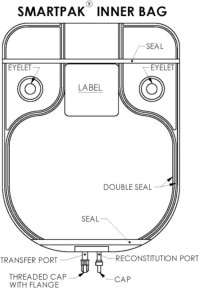
- Document the date and time reconstitution starts in the designated place on the container label. The entire contents of the bag must be used within 4 hours from the time of initial entry.
- Remove the translucent unthreaded cap from the reconstitution (smaller) port and discard it.
- Reconstitute the powder through the reconstitution (smaller) port, using Sterile Water for Injection according to the table below
Reconstitution Table SmartPak® Bag Size Amount of Sterile Water Approximate Concentration 100 grams 960 mL 100 mg/mL (1 g/10 mL) 300 grams 2880 mL 100 mg/mL (1 g/10 mL) - After reconstitution is complete, remove the transfer needle from the reconstitution port.
- Place the bag on a flat surface of a laminar flow hood and mix for at least 15 minutes for the 100 gram product or 25 minutes for the 300 gram product by rocking gently from side to side. CAUTION: To avoid possible leakage caused by the heavy weight of the added water, do not shake vigorously or pull strongly on the bag.
- When foam dissipates, visually inspect the bag to verify the solution is clear, colorless to pale yellow and free of particulate matter. DO NOT USE THE INNER BAG IF PARTICULATE OR FOREIGN MATTER IS PRESENT.
- Unscrew the clear threaded cap from the transfer (larger) port and discard it. Attach sterile tubing and filling adapter unit to the transfer port.
- Reconstituted solution can now be transferred using the transfer port and the filling adapter.
It should be noted that the spike placed into the transfer port of the Pharmacy Bulk Package SmartPak® is NEVER removed during this procedure and that the reconstitution port is self-sealing.
Dilution
- Hang the bag from two eyelets.
- Following reconstitution, transfer 10 mL of the reconstituted solution into transfusion bags, each containing 50 mL of one of the compatible solutions below.
Compatible solutions for dilution are the following:
Sodium Chloride Injection, USP
5% Detrose Injection, USP- Dilution should be completed within the 4 hour preparation process.
- When diluted according to the instructions above, cefazolin is stable for 24 hours at room temperature or for 10 days if stored under refrigeration (5°C or 41°F).
Administration
Prior to administration, parenteral drug products should be inspected visually for particulate matter and discoloration whenever solution and container permit.
- 3 DOSAGE FORMS AND STRENGTHS
-
4 CONTRAINDICATIONS
4.1 Hypersensitivity to Cefazolin or the Cephalosporin Class of Antibacterial Drugs, Penicillins or Other Beta-lactams
Cefazolin for Injection, USP is contraindicated in patients who have a history of immediate hypersensitivity reactions (e.g., anaphylaxis, serious skin reactions) to cefazolin or the cephalosporin class of antibacterial drugs, penicillins or other beta-lactams [see Warnings and Precautions (5.1)].
-
5 WARNINGS AND PRECAUTIONS
5.1 Hypersensitivity Reactions to Cefazolin, Cephalosporins, Penicillins or Other Beta-lactams
Serious and occasionally fatal hypersensitivity (anaphylactic) reactions have been reported in patients receiving beta-lactam antibacterial drugs. Before therapy with Cefazolin for Injection, USP is instituted, careful inquiry should be made to determine whether the patient has had previous immediate hypersensitivity reactions to cefazolin, cephalosporins, penicillins, or carbapenems. Exercise caution if this product is to be given to penicillin-sensitive patients because cross-hypersensitivity among beta-lactam antibacterial drugs has been clearly documented and may occur in up to 10% of patients with a history of penicillin allergy. If an allergic reaction to Cefazolin for Injection, USP occurs, discontinue the drug.
5.2 Use in Patients with Renal Impairment
Cefazolin for Injection USP – Pharmacy Bulk Package bags SmartPak® should not be used in renally impaired patients who require less than a 250 mg dose of cefazolin.
As with other beta-lactam antibacterial drugs, seizures may occur if inappropriately high doses are administered to patients with impaired renal function (creatinine clearance less than 55 mL/minute) [see Dosage and Administration (2.3)].
5.3 Clostridium difficile-associated Diarrhea
Clostridium difficile associated diarrhea (CDAD) has been reported with the use of nearly all antibacterial agents, including cefazolin and may range in severity from mild diarrhea to fatal colitis. Treatment with antibacterial agents alters the normal flora of the colon leading to overgrowth of C. difficile.
C. difficile produces toxins A and B, which contribute to the development of CDAD. Hypertoxin- producing isolates of C. difficile cause increased morbidity and mortality, as these infections can be refractory to antimicrobial therapy and may require colectomy. CDAD must be considered in all patients who present with diarrhea following antibacterial drug use. Careful medical history is necessary since CDAD has been reported to occur over two months after the administration of antibacterial agents.
If CDAD is suspected or confirmed, ongoing antibacterial drug use not directed against C. difficile may need to be discontinued. Appropriate fluid and electrolyte management, protein supplementation, antibacterial drug treatment of C. difficile, and surgical evaluation should be instituted as clinically indicated.
5.4 Risk of Development of Drug-resistant Bacteria
Prescribing Cefazolin for Injection, USP in the absence of proven or strongly suspected bacterial infection or a prophylactic indication is unlikely to provide benefit to the patient and increases the risk of the development of drug-resistant bacteria.
As with other antimicrobials, prolonged use of Cefazolin for Injection, USP may result in overgrowth of nonsusceptible microorganisms. Repeated evaluation of the patient's condition is essential. Should superinfection occur during therapy, appropriate measures should be taken.
5.5 Drug/Laboratory Test Interactions
Urinary Glucose
The administration of cefazolin may result in a false-positive reaction with glucose in the urine when using CLINITEST® tablets. It is recommended that glucose tests based on enzymatic glucose oxidase reactions (e.g., CLINISTIX®) be used.
Coombs' Test
Positive direct Coombs tests have been reported during treatment with cefazolin, In hematologic studies or in transfusion-cross-matching procedures when antiglobulin tests are performed on the minor side or in Coombs' testing of newborns whose mothers have received cephalosporin antibacterial drugs before parturition, it should be recognized that a positive Coombs' test may be due to the drug.
-
6 ADVERSE REACTIONS
The following serious adverse reactions to cefazolin are described below and elsewhere in the labeling:
- Hypersensitivity reactions [See Warnings and Precautions (5.1)]
- Clostridium difficile-associated diarrhea [see Warnings and Precautions (5.3)]
6.1 Clinical Trials Experience
The following adverse reactions were reported from clinical trials:
Gastrointestinal: Diarrhea, oral candidiasis (oral thrush), mouth ulcers, vomiting, nausea, stomach cramps, epigastric pain, heartburn, flatus, anorexia, and pseudomembranous colitis. Onset of pseudomembranous colitis symptoms may occur during or after antibacterial treatment [see Warnings and Precautions (5.3)].
Allergic: Anaphylaxis, eosinophilia, urticaria, itching, drug fever, skin rash, Stevens-Johnson syndrome.
Hematologic: Neutropenia, leukopenia, thrombocytopenia, thrombocythemia.
Hepatic: Transient rise in SGOT, SGPT, and alkaline phosphatase levels has been observed. As with other cephalosporins, reports of hepatitis have been received.
Renal: As with other cephalosporins, reports of increased BUN and creatinine levels, as well as renal failure, have been received.
Local Reactions: Instances of phlebitis have been reported at site of injection. Some induration has occurred.
Other Reactions: Pruritus (including genital, vulvar and anal pruritus, genital moniliasis, and vaginitis). Dizziness, fainting, lightheadedness, confusion, weakness, tiredness, hypotension, somnolence and headache.
6.2 Cephalosporin-class Adverse Reactions
In addition to the adverse reactions listed above that have been observed in patients treated with cefazolin, the following adverse reactions and altered laboratory tests have been reported for cephalosporin-class antibacterials: Stevens-Johnson syndrome, erythema multiforme, toxic epidermal necrolysis, renal impairment, toxic nephropathy, aplastic anemia, hemolytic anemia, hemorrhage, hepatic impairment including cholestasis and pancytopenia.
- 7 DRUG INTERACTIONS
-
8 USE IN SPECIFIC POPULATIONS
8.2 Labor and Delivery
When cefazolin has been administered prior to caesarean section, drug concentrations in cord blood have been approximately one quarter to one third of maternal drug levels. The drug appears to have no adverse effect on the fetus.
8.3 Nursing Mothers
Cefazolin is present in very low concentrations in the milk of nursing mothers. Caution should be exercised when cefazolin is administered to a nursing woman.
8.4 Pediatric Use
Cefazolin for Injection USP, Pharmacy Bulk Package bag, SmartPak® should not be used in pediatric patients who require less than a 250 mg adult of cefazolin.
8.5 Geriatric Use
Of the 920 subjects who received cefazolin in clinical studies, 313 (34%) were 65 years and over, while 138 (15%) were 75 years and over. No overall differences in safety or effectiveness were observed between these subjects and younger subjects. Other reported clinical experience has not identified differences in responses between the elderly and younger patients, but greater sensitivity of some older individuals cannot be ruled out.
This drug is known to be substantially excreted by the kidney, and the risk of toxic reactions to this drug may be greater in patients with impaired renal function. Because elderly patients are more likely to have decreased renal function, care should be taken in dose selection, and it may be useful to monitor renal function [see Dosage and Administration (2.3) and Warnings and Precautions (5.2)].
8.6 Patients with Renal Impairment
Cefazolin for Injection USP, Pharmacy Bulk Package bag, SmartPak® should not be used in patients with renal impairment who require less than a 250 mg dose of Cefazolin. When cefazolin is administered to patients with low urinary output because of impaired renal function (creatinine clearance less than 55 mL/minute), lower daily dosage is required [see Dosage and Administration (2.3) and Warnings and Precautions (5.2)].
-
11 DESCRIPTION
Cefazolin for Injection USP, Pharmacy Bulk Package bag SmartPak® should not be used in patients who require less than a 250 mg dose of cefazolin.
Cefazolin for Injection, USP, is a sterile, lyophilized, semisynthetic cephalosporin for intravenous administration. It is the sodium salt of 3-{[(5-methyl-1,3,4-thiadiazol-2-yl)thio]-methyl}-8-oxo-7- [2-(1H -tetrazol-1-yl)acetamido]-5-thia-1-azabicyclo [4.2.0]oct-2-ene-2-carboxylic acid. Each Pharmacy Bulk Package contains 48 mg (2.1 mEq) of sodium per 1 gram of cefazolin sodium. Cefazolin for Injection, USP, is supplied in 100 grams and 300 grams SmartPak® Pharmacy Bulk Packages bags equivalent. Each SmartPak® Pharmacy Bulk Package bag contains cefazolin sodium equivalent to 100 grams or 300 grams of cefazolin.
BEFORE ADMINISTRATION, THIS PHARMACY BULK PACKAGE REQUIRES RECONSTITUTION USING STERILE WATER FOR INJECTION, USP TO A CONCENTRATION OF 100 mg per mL AND FURTHER DILUTION IN 50 mL OF A COMPATIBLE SOLUTION AND INFUSED INTRAVENOUSLY.
A Pharmacy Bulk Package is a container of a sterile preparation for intravenous use that contains many single doses. The contents are intended for use in a pharmacy admixture service and are restricted to the preparation of admixtures for intravenous infusion.
The molecular formula is C14H13N8NaO4S3. The molecular weight is 476.49.
The structural formula is as follows:

The pH of the reconstituted solution is between 4 and 6.
-
12 CLINICAL PHARMACOLOGY
12.2 Pharmacodynamics
The pharmacokinetic/pharmacodynamic relationship for cefazolin has not been evaluated in patients.
12.3 Pharmacokinetics
Studies have shown that following intravenous administration of cefazolin to normal volunteers, mean serum concentrations peaked at approximately 185 mcg/mL and were approximately 4 mcg/mL at 8 hours for a 1 gram dose.
The serum half-life for cefazolin is approximately 1.8 hours following IV administration.
In a study, using normal volunteers, of constant intravenous infusion with dosages of 3.5 mg/kg for 1 hour (approximately 250 mg) and 1.5 mg/kg the next 2 hours (approximately 100 mg), cefazolin produced a steady serum level at the third hour of approximately 28 mcg/mL.
Plasma pharmacokinetic parameters of cefazolin in normal volunteers (N=12) following a single 15-minute intravenous infusion of 2 grams of Cefazolin for Injection, USP are summarized in Table 3.
Table 3: Mean (Standard Deviation) Plasma Pharmacokinetic Parameters of Cefazolin in Normal Volunteers *Tmax reported as median( range)
N = number of subjects observed; Cmax = maximum plasma concentration; Tmax = time to maximum plasma concentration; AUC0-inf = area under the plasma concentration-time curve extrapolated to infinity; t½ = apparent plasma terminal elimination half-life; CL = total clearance; Vz = volume of distribution
N Cmax
(mcg/mL)Tmax*
(h)AUC0-inf
(mcg*h/mL)t½
(h)CL
(L/h)Vz
(L)Single 2 g Dose as a 15-Minute I.V. Infusion 12 280.9
(45.9)0.25
(0.25-0.33)509.9 (89.3) 2.01 (0.28) 4.03 (0.68) 11.5 (1.53) Studies in patients hospitalized with infections indicate that cefazolin produces mean peak serum levels approximately equivalent to those seen in normal volunteers.
Bile levels in patients without obstructive biliary disease can reach or exceed serum levels by up to five times; however, in patients with obstructive biliary disease, bile levels of cefazolin are considerably lower than serum levels (< 1.0 mcg/mL).
In synovial fluid, the cefazolin concentration becomes comparable to that reached in serum at about 4 hours after drug administration.
Studies of cord blood show prompt transfer of cefazolin across the placenta. Cefazolin is present in very low concentrations in the milk of nursing mothers.
Cefazolin is excreted unchanged in the urine. In the first 6 hours approximately 60% of the drug is excreted in the urine and this increases to 70% to 80% within 24 hours.
12.4 Microbiology
Mechanism of Action
Cefazolin is a bactericidal agent that acts by inhibition of bacterial cell wall synthesis.
Resistance
Predominant mechanisms of bacterial resistance to cephalosporins include the presence of extended-spectrum beta-lactamases and enzymatic hydrolysis.
Antimicrobial Activity
Cefazolin has been shown to be active against most isolates of the following microorganisms both in vitro and in clinical infections as described in the INDICATIONS AND USAGE (1) section.
- Gram-Positive Bacteria
- Staphylococcus aureus
- Staphylococcus epidermidis
- Streptococcus agalactiae
- Streptococcus pneumoniae
- Streptococcus pyogenes
Methicillin-resistant staphylococci are uniformly resistant to cefazolin,
- Gram-Negative Bacteria
- Escherichia coli
- Proteus mirabilis
Most isolates of indole positive Proteus (Proteus vulgaris), Enterobacter spp., Morganella morganii, Providencia rettgeri, Serratia spp. and Pseudomonas spp. are resistant to cefazolin.
Susceptibility Testing
For specific information regarding susceptibility test interpretive criteria and associated test methods and quality control standards recognized by FDA for this drug, please see: https://www.fda.gov/STIC
- Gram-Positive Bacteria
- 13 NONCLINICAL TOXICOLOGY
-
16 HOW SUPPLIED/STORAGE AND HANDLING
Cefazolin for Injection, USP, is available in the following SmartPak® Pharmacy Bulk Packages bags:
100 grams* One Pharmacy Bulk Package bag Product No. 1100 NDC 66288-1100-1
300 grams** One Pharmacy Bulk Package bag Product No. 1300 NDC 66288-1300-1
*Each 100 gram Pharmacy Bulk Package bag contains sterile cefazolin sodium equivalent to 100 grams of cefazolin.
**Each 300 gram Pharmacy Bulk Package bag contains sterile cefazolin sodium equivalent to 300 grams of cefazolin.
SmartPak® system components are not made with natural rubber latex.
As with other cephalosporins, cefazolin tends to darken depending on storage conditions within the stated recommendations; however, product potency is not adversely affected.
Storage Conditions
Prior to reconstitution, store dry powder at 20° to 25° C (68° to77° F). [See USP Controlled Room Temperature]. Protect From Light.
-
17 PATIENT COUNSELING INFORMATION
Patients should be advised that allergic reactions, including serious allergic reactions could occur and that serious reactions require immediate treatment and discontinuation of cefazolin. Patients should report to their health care provider any previous allergic reactions to cefazolin, cephalosporins, penicillins or other similar antibacterials.
Patients should be advised that diarrhea is a common problem caused by antibiotics, which usually ends when the antibiotic is discontinued. Sometimes after starting treatment with antibacterials, patients can develop watery and bloody stools (with or without stomach cramps and fever) even as late as two or more months after having taken the last dose of the antibacterials. If this occurs, patients should contact a physician as soon as possible.
Patients should be counseled that antibacterial drugs including cefazolin, should only be used to treat bacterial infections. They do not treat viral infections (e.g., the common cold). When cefazolin is prescribed to treat a bacterial infection, patients should be told that although it is common to feel better early in the course of therapy, the medication should be taken exactly as directed. Skipping doses or not completing the full course of therapy may: (1) decrease the effectiveness of the immediate treatment, and (2) increase the likelihood that bacteria will develop resistance and will not be treatable by cefazolin or other antibacterial drugs in the future.
Rx only
SmartPak is a registered trademark of Samson Medical Technologies, L.L.C.
Clinitest is a registered trademark of Siemens Medical Solutions Diagnostics.
Clinistix is a registered trademark of Bayer Healthcare LLC.C1100i
Manufactured for
SAMSON MEDICAL TECHNOLOGIES, L.L.C.
Cherry Hill, NJ 08003
by
ACS Dobfar S.p.A.
20067 Tribiano (Milano) Italy
- PRINCIPAL DISPLAY PANEL
- PRINCIPAL DISPLAY PANEL
- PRINCIPAL DISPLAY PANEL
- PRINCIPAL DISPLAY PANEL
-
INGREDIENTS AND APPEARANCE
CEFAZOLIN
cefazolin sodium injection, powder, lyophilized, for solutionProduct Information Product Type HUMAN PRESCRIPTION DRUG Item Code (Source) NDC:66288-1100 Route of Administration INTRAVENOUS Active Ingredient/Active Moiety Ingredient Name Basis of Strength Strength Cefazolin Sodium (UNII: P380M0454Z) (Cefazolin - UNII:IHS69L0Y4T) Cefazolin 100 g Packaging # Item Code Package Description Marketing Start Date Marketing End Date 1 NDC:66288-1100-1 1 in 1 BAG; Type 0: Not a Combination Product 01/01/2007 Marketing Information Marketing Category Application Number or Monograph Citation Marketing Start Date Marketing End Date ANDA ANDA065141 01/01/2007 CEFAZOLIN
cefazolin sodium injection, powder, lyophilized, for solutionProduct Information Product Type HUMAN PRESCRIPTION DRUG Item Code (Source) NDC:66288-1300 Route of Administration INTRAVENOUS Active Ingredient/Active Moiety Ingredient Name Basis of Strength Strength Cefazolin Sodium (UNII: P380M0454Z) (Cefazolin - UNII:IHS69L0Y4T) Cefazolin 300 g Packaging # Item Code Package Description Marketing Start Date Marketing End Date 1 NDC:66288-1300-1 1 in 1 BAG; Type 0: Not a Combination Product 01/01/2007 Marketing Information Marketing Category Application Number or Monograph Citation Marketing Start Date Marketing End Date ANDA ANDA065141 01/01/2007 Labeler - Samson Medical Technologies, L.L.C. (102837429) Establishment Name Address ID/FEI Business Operations ACS Dobfar S.p.A. 429243025 MANUFACTURE(66288-1100, 66288-1300)



